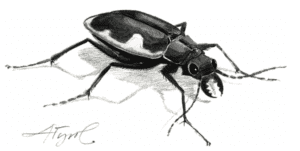By Declan McCabe
Earlier this summer, I joined graduate school friend and beetle biologist, Kristian Omland, in search of the elusive cobblestone tiger beetle (Cicindela marginipennis). We loaded a canoe with insect nets, jars, and binoculars to view beetles while minimizing handling. Absent from our kit: entomologist’s killing jars. Ours was a catch-and-release mission.
The cobblestone tiger beetle is a species of greatest conservation need (SGCN), and we certainly would do nothing to lower its numbers. The cobblestone tiger beetle is a half-inch-long, brown to olive green, lanky, fast-moving insect. The elytra covering its flying wings are bordered by a cream-colored stripe. When it raises its elytra to fly, this beetle reveals a fire engine-red abdomen. Long legs keep the beetle off sunbaked stones, and dense white hairs on its underside reduce radiant heating from below.

Adult tiger beetles run and fly rapidly to chase down smaller insects. They use long, sickle-shaped, toothy mandibles to catch and perforate prey insects, then release enzymes and acids strong enough to put holes in an entomologist’s net. This results in a soupy meal, which the beetle eats before discarding its prey’s empty husk. Larvae use a different hunting strategy. They live in vertical tunnels in soil and use their armored and camouflaged heads and first thoracic segments to plug the entrances to these tunnels. Should an ant or other small insect get close enough, the larva grabs the prey using its mandibles and drags it below ground to make a meal of it.
Habitat loss is the most likely factor to this species’ inclusion on the regional SGCN list. Each tiger beetle species has a particular niche, and as their name suggests, cobblestone tiger beetles favor cobble-strewn beaches, islands, and gravel bars in large rivers. Females use long ovipositors to make holes in the soil and lay their eggs. Once hatched, larvae enlarge holes by tossing out sand and silt; the resulting “throw piles” of debris can be helpful in locating larval burrows.
The best strategy for preserving these beautiful insects is likely protecting cobblestone beaches in areas where they live, including along the Connecticut River, which runs between New Hampshire and Vermont, Vermont’s Winooski River, the Pemigewasset River in New Hampshire, and Maine’s Carrabassett River. River dams are the single largest threat to these habitats. Free-flowing rivers move across their floodplains building, eroding, and rebuilding sand and gravel bars, beaches, and islands such that cobblestone features in rivers vary in age from freshly-formed, to long-established. Beaches of different ages provide different microhabitats for a range of organisms and increase biological diversity in river corridors.
New beaches lack vegetation. Gradually, plants such as dogbane move in and stabilize substrates. The next successional stage includes willow saplings and cottonwoods that in time grow to be substantial trees. Occasional Tropical Storm Irene-scale floods reset the system by removing vegetation and redepositing sediments. Receding floods first drop the largest rocky sediments and cobbles, then gravel, followed by sand, and eventually silt. This sediment sorting leaves cobblestone beaches high and dry above the water line – creating prime real estate for cobblestone tiger beetles.
Dams hinder this natural beach rebuilding process, thereby eliminating several microhabitat types for significant distances upstream. This eradicates habitat for cobblestone beetles and for a whole set of other species, including plants, insects, and the birds and fish that rely on them for shelter and food. Other habitat threats include invasive plants, use of insecticides, riverbank stabilization efforts, water pollution, and off-road vehicles.
Kristian and I searched cobblestone beaches by walking near dogbane patches and on newer plant-free beaches and mid-channel bars. The first gravel bar we visited was at the confluence of the Huntington and Winooski rivers, where Jonathan Leonard, coauthor of “Northeastern Tiger Beetles,” and his daughter Emma found cobblestone beetles in 1997, and where Kristian has seen them since.
We were rewarded by tiger beetle sightings, but of a different species. The common shore tiger beetle (Cicindela repanda) is less picky about habitats and was the only tiger beetle species we saw on our trip. Other scientists have observed cobblestone tiger beetles later in the summer, and so I think additional canoe trips are warranted. I’m happy to have any excuse for more time on the river.
Declan McCabe teaches biology at Saint Michael’s College. His first book, “Turning Stones: Exploring Life in Freshwater” will soon be published by McDonald and Woodward. Illustration by Adelaide Murphy Tyrol. The Outside Story is assigned and edited by Northern Woodlands magazine and sponsored by the Wellborn Ecology Fund of the New Hampshire Charitable Foundation: nhcf.org. This piece received additional support from the Arthur Getz Trust, Citizens Bank, N.A., Trustee.




